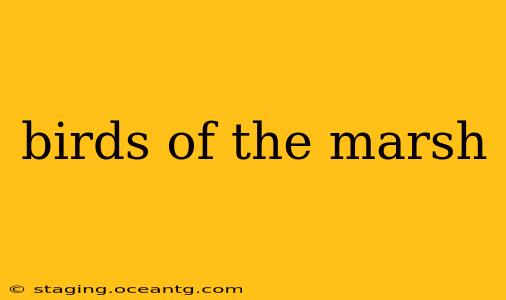Marshes, those vibrant ecosystems brimming with life, support a remarkable diversity of bird species. From the smallest wading birds to majestic raptors, these wetlands offer crucial habitats for breeding, feeding, and migrating. This comprehensive guide delves into the fascinating world of marsh birds, exploring their adaptations, behaviors, and the vital role they play in maintaining the delicate balance of these unique environments.
What types of birds live in marshes?
Marshes provide a haven for a wide array of avian species, each uniquely adapted to the challenges and opportunities of this environment. Common inhabitants include wading birds like herons (Great Blue Heron, Great Egret), egrets, ibises, and bitterns, all skilled at navigating shallow waters in search of fish, amphibians, and crustaceans. Shorebirds, such as sandpipers, plovers, and stilts, frequent the marsh edges, probing the mud for invertebrates. Ducks, geese, and other waterfowl find refuge and abundant food sources within the marsh vegetation. Finally, raptors like marsh hawks and ospreys utilize the marsh's cover for hunting, preying on the abundant fish and smaller animals. The specific species present will vary depending on the geographic location and characteristics of the marsh itself.
What are the characteristics of birds that live in marshes?
Marsh birds exhibit a range of adaptations that enable them to thrive in their challenging habitat. Many possess long legs for wading through shallow water, while some have specialized beaks for probing mud or catching fish. Camouflage is crucial, with many species exhibiting plumage that blends seamlessly with the reeds and vegetation. Their ability to tolerate varying water levels and fluctuating salinity is also a key adaptation. Some species, like the secretive bitterns, have developed incredible camouflage and stillness techniques to avoid predation and ambush prey.
How do birds adapt to living in a marsh?
Adaptation is key to survival in a marsh environment. Consider the following adaptations:
- Long legs: Ideal for wading through shallow water to access food sources.
- Specialized beaks: Different beak shapes allow for specialized feeding strategies, from probing mud to catching fish.
- Camouflage: Cryptic plumage helps birds blend in with the marsh vegetation, avoiding both predators and prey.
- Waterproofing: Specialized feathers and oils help birds stay dry and warm in a wet environment.
- Tolerance to salinity: Many marsh birds can tolerate varying levels of salinity in the water.
What birds are endangered that live in marshes?
Unfortunately, many marsh bird populations are facing threats due to habitat loss, pollution, and climate change. Several species are considered endangered or threatened, including some subspecies of the King Rail, the California Clapper Rail, and various waterfowl depending on regional factors. Conservation efforts are crucial to protecting these vulnerable species and their vital wetland habitats.
What are the benefits of birds living in marshes?
Beyond their intrinsic value, marsh birds play essential roles in maintaining the health of the ecosystem. They act as natural pest control, consuming insects and other invertebrates that could otherwise damage marsh vegetation. Their feeding habits also help to regulate fish populations and nutrient cycling within the marsh. Furthermore, birds serve as indicators of environmental health; changes in their populations can signal broader environmental problems.
How can I attract birds to my marsh?
Creating a bird-friendly marsh requires maintaining a healthy and diverse habitat. This includes providing a variety of food sources (seeds, insects, fish), clean water, and ample nesting sites within the vegetation. Minimizing disturbance and pollution is also crucial. Planting native vegetation can attract a wider range of species, while providing shelter and nesting opportunities.
Conclusion
The birds of the marsh represent a fascinating and vital component of these unique ecosystems. Understanding their adaptations, behaviors, and ecological roles is essential for effective conservation and appreciating the biodiversity of these vibrant wetlands. By protecting and restoring marsh habitats, we safeguard not only these remarkable birds but also the intricate balance of the entire ecosystem.
